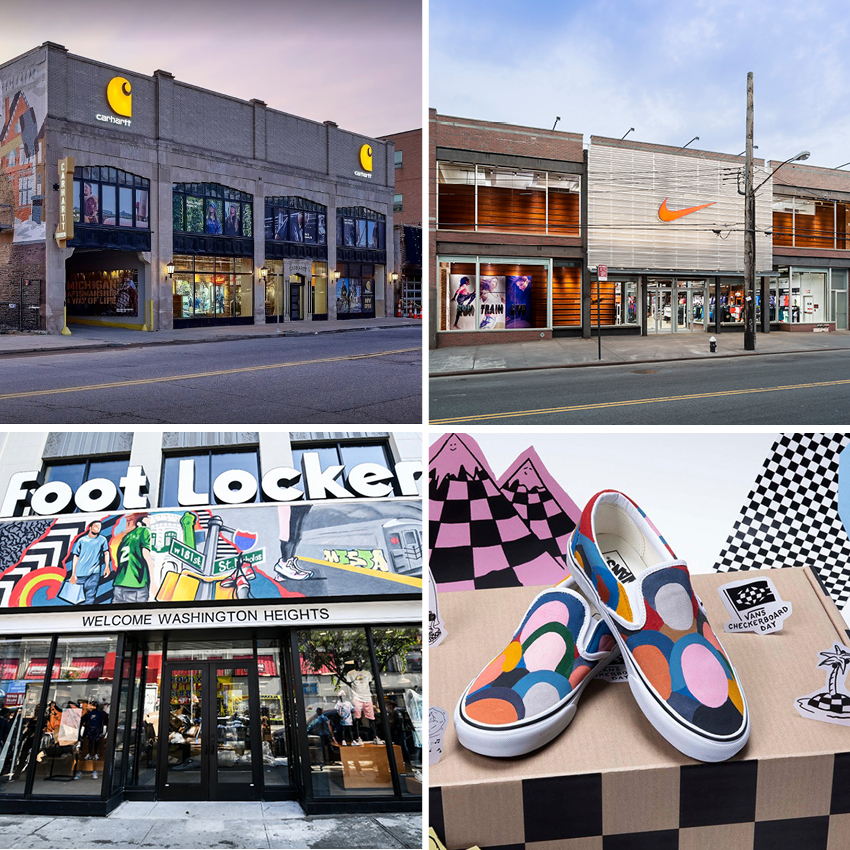In 2015 NIKE opened a Community Store in Brooklyn; It’s not in Williamsburg or Dumbo, it’s in Flatbush. Flatbush is hardly an international retail mecca. In fact, the store is near the last downtown stop, at the end of the number two subway line. The NIKE Community Store model has expanded to include downtown Detroit, Ivy City in D.C., mid-city New Orleans, South Chicago, Portland Oregon, East Los Angeles, and the newest location, which opened in August of 2020 in the Watts neighborhood of L.A. The game plan of breathing authenticity and local culture into the essence of a store goes deeper, WWD described the emphasis of local engagement specific to the Watts Community Store that is emblematic of the initiative. “Nike hired 85 percent of the staff from within three miles of the store, is allocating paid volunteer hours for employees to give back and is supporting local organizations through an employee-led grant program.” NIKE is not alone in opening stores in what might be referred to as retail deserts. Footlocker has a like-minded approach expressed in the brand’s neighborhood Power stores, each with an identity tailored to the location.
In Detroit, hometown fashion-workwear retailer Carhartt joined the Detroit renaissance effort, opening a 4000-foot flagship in a landmarked 1928 Art Deco building. On the second floor, Carhartt created an open workshop space (temporarily closed due to Covid), and a free tool-lending library for locals to work on DIY projects.
[callout]Brands have nodded to social responsibility for years. This time it is different. Businesses are facing a generation of socially attuned consumers who have gained dominance in the marketplace. This generation craves quantifiable social efforts, and they expect a brand to stand for something.[/callout]
For the skateboard and surf-inspired brand Vans, this approach is nothing new. Vans, which is aiming to be a $5 billion company by fiscal 2023, has community built into the brand’s DNA. A recent article in Forbes quotes Global Brand President Doug Palladini, “We\’re trying to be a part of the world we want to represent. You can\’t hire a third-party agency to tell you what\’s cool with Group X while you sit at your desk and answer emails. You need to go see it yourself… Many companies make the mistake of trying to hijack popular culture. Vans’ strategy has been to invest in localized communities that have helped the brand position itself as genuine.”
In spring 2020, with much of the world on lockdown, Vans, owned by VF Corporation, checked in with their virtual community. The Shoebox Challenge was introduced, Vans challenged fans to transform shoeboxes “into a mini skate park, or your own mini wave pool. Maybe you want to make a little robot, a creature from outer space, or a DIY guitar?” The brand would feature select designs and reward a few creators with “Vans Custom Codes to design their own pair, on us.” Another effort was “Foot The Bill”, developed to support local skateboard shops, restaurants, art galleries, and music venues enduring shutdowns. The program allowed the businesses, using the Vans custom shoe platform, to collaborate with local artists in creating limited edition Vans sneakers. The net proceeds from the sales went directly to the small business. The initiative generated $4 million for the struggling enterprises. To encourage “mental health and well-being during the isolation period”, the brand established “Checkerboard Day”. Vans has long embraced creative expression; this effort aligns with that brand-culture touchpoint. “Vans will support 10 charities from around the world whose shared purpose is to use programs focused on creativity as resources for coping with the stressors that impact mental health and well-being, by donating a collective $1 million.”
Purpose-Driven
Brands have nodded to social responsibility for years. This time it is different. Businesses are facing a generation of socially attuned consumers who have gained dominance in the marketplace. This generation craves quantifiable social efforts, and they expect a brand to stand for something. The community-focused efforts represent the intersection of commerce and purpose. The hyper-localization of established U.S. based brands adds a new dimension to retail. The strategy which manifested as early as 2015, now seems strikingly prescient.
Picking Up the Pieces
The calamitous fall of privately-owned retailers during this pandemic creates an opportunity for this community model to become a bridge between local retail and a mega-brand, as well as a complement to e-commerce. In addition, the optimization of artificial intelligence gives the brands an assist in getting the location, tone, inventory, and pricing right. The abundance of granular data generated by a large-brands and broken down by neighborhood, combined with creativity, allows the community stores to surpass purpose by creating a bespoke shopping experience that reflects a neighborhood.
Switching Tracks
As many malls continue to falter, fail, and a few become re-purposed as senior living facilities, retailers searching for alternative locations are increasingly considering smaller urban venues. While established with a different value proposition than the community-oriented stores, Nordstrom is expanding the Nordstrom Local model. IKEA announced the opening of fifty smaller urban stores globally. Jeff Genette announced that Macy’s and Bloomingdales will be testing smaller stores in cities with the goal of “ Strengthening customer relationships, curating quality fashion, accelerating digital growth, optimizing the store portfolio, and resetting the cost base.
If Macy’s adds creativity and neighborhood customization to that formula, we might see what began as an experiment at the end of the subway line point to the beginning of a new journey for consumers and retailers.




